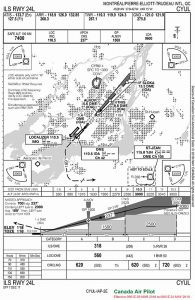Instrument Flight Procedures includes the design, implementation and use of instument flight procedures for all phases of flight in the vicinity of an aerodrome, as well as the transition to and from en-route airspace, and associated procedures. The domain also encompasses new capabilities such as performance-based navigation (PBN) as well as the emerging requirements for increased accuracy, the use of automation, the need for quality assurance and the consideration of environmental issues in instrument flight procedure designs.

|
What falls under Instrument Flight Procedures?
According to the Instrument Flight Procedures Panel (IFPP), the following areas of expertise are an integral part of instrument flight procedures (ICAO, 2014):
- new instrument flight procedure (IFP) design criteria to address improvements in air navigation, evolving aircraft capabilities and new operational concepts;
- instrument flight procedure oversight requirements;
- harmonization of charting criteria, databases, and avionics systems guidance with IFP design standards;
- elements of instrument flight procedures that are enablers for the facilitation of an efficient communication between ATC and Flight Crews;
- necessary amendments (maintenance) to existing instrument flight procedures provisions: ILS, MLS, LPV, LNAV/VNAV, LOC, VOR, NDB, etc.
For more information, visit one of the following WIKIFATCA pages: |
Instrument Flight Procedures 91
- AAS 1.04 REQUIRED NAVIGATION PERFORMANCE (RNP) and AREA NAVIGATION (RNAV)
- AAS 1.07 DISPLAY OF GNSS STATUS TO ATC
- AAS 1.09 REMOVAL OF GROUND BASED AIDS
- AAS 1.11 “FLY-BY” AND “FLY-OVER” WAYPOINTS
- AAS 1.15 CONCEPT OF GNSS-BASED ALTITUDE
- ADME 2.8 ADVANCED APPROACH PROCEDURES
- ADME 2.9 REQUIRED NAVIGATION PERFORMANCE (RNP) FOR APPROACH AND LANDING
- Aerodrome – Categorization of Approach Types
- Air Traffic Management for Tiltrotors
- Airspace Design and Procedures Controller Involvement
- Amendment to Current Policy on RNAV Procedural Separation Minima
- ATS – Study Restrictions in the Enroute Environment
- ATS – Study SID and STAR Design
- ATS 3.2 CLEARANCES
- ATS 3.22 MISSED APPROACH PROCEDURES FOR VISUAL APPROACHES
- ATS 3.23 INSTRUMENT DEPARTURES AND ARRIVALS
- ATS 3.24 EN-ROUTE RESTRICTIONS
- ATS 3.25 CONTINUOUS DESCENT OPERATIONS (CDO) AND CONTINOUS CLIMB OPERATIONS (CCO)
- ATS 3.27 SID AND STAR NAMING
- ATS 3.34 TERRAIN AND OBSTACLE CLEARANCE RESPONSIBILITIES
- ATS 3.35 TERRAIN AND OBSTACLE CHARTING
- ATS 3.42 HELICOPTER OPERATIONS
- ATS 3.8 RADAR MONITORING
- Autoland Communication Between Pilots and Controllers in Good Weather Conditions
- Civilian and Military Integration in the Same Workspace
- COM 4.12 AUTOLAND COMMUNICATION BETWEEN PILOTS AND CONTROLLERS
- Compatibility in Clearances Issued
- Concept of GNSS-Based Altitude
- Developments in the use of Global Navigation Satellite Systems (GNSS) as an Approach Aid
- Dynamic and Flexible ATS Route Systems
- Environmental Issues in ATM
- From RNAV Visual Approaches to Visual Guided Approaches Supplemented by RNAV
- Harmonised Transition Altitude
- Introduction to GNSS Landing Systems
- Investigate Basic / Advanced Continuous Descent Approaches
- Investigate Navigation and Surveillance Provided by a Single Position Information System
- Investigate Operational Use of Level Restrictions in SIDs, STARs and other Published Routes
- MLS Operational Procedures
- Monitor the Application and Implementation of RNAV
- Monitoring TIBA
- Navigation – Magnetic vs True
- Off–Set Tracking in the North Atlantic (NAT)
- Optimisation of Climb and Descent Profiles and Fuel Economy
- Policy Review AAS 1.8 – 4D Trajectory Concepts / Management
- Policy Review: Strategic Lateral Offset Procedures (SLOP)
- Produce Definitions of “Fly-by” and “Fly-over”
- Radar Monitoring Procedures in TMAs
- Radio Mandatory Zones / Transponder Mandatory Zones
- Removal of Ground Based Aids
- Report of Visual Approach Procedures
- Review Continuous Descent Operations Manual
- Review ICAO Manual on Performance Based Navigation
- Review of IFATCA Policy Concerning Helicopter Operations
- Review of Policy on Advanced Approach Procedures
- Review of Policy on Area Navigation
- Review of Policy on MLS
- Review of Policy on Precision Area Navigation
- Review policy of ACAS / TCAS
- Review Provisional Policy on Missed Approach after Visual Approach
- Revision of Advanced Approach Policy
- RNAV – Monitoring its Implementation
- RNAV Procedural Separation – Amendment of Current Policy
- RNAV Procedural Separation – Longitudinal Distance Standard Minima
- RNP for Approach and Landing
- RNP for Approach and Landing
- Separation in Class E Airspace
- SID/STAR Phraseology
- Simultaneous Operations on Intersecting Runways
- Study Continuous Climb Operations
- Study Go Around Procedures When on Visual Approach
- Study Merging and Sequencing Concepts
- Study of User Driven Prioritisation Process (UDPP)
- Study SID and STAR Naming and Relevant FMS Design
- Study the Concept of Block Upgrades
- Study the Operation of Aircraft Flight Management Systems
- Study Visual Separation on Approach
- Surveillance Applications Policy – Applications of Radar Monitoring
- Terrain and Obstacle Charting
- Terrain and Obstacle Clearance Responsibilities
- Terrain Clearance and Airspace Design
- The “Free Flight Concept” – Human Factors Considerations
- The Development of MLS Continues
- The Development of the Microwave Landing System ( MLS)
- The Use of GNSS – ATC
- The Use of GNSS as a Runway Approach Aid
- The Use of Lateral Offsets
- The Use of Lateral Offsets
- The Use of Non-flight Plannable Levels in the Nat Region for Contingency
- TPM Review – ATS Editorials
- Transition Altitudes
- Use of Datalink in A Microwave Landing System


